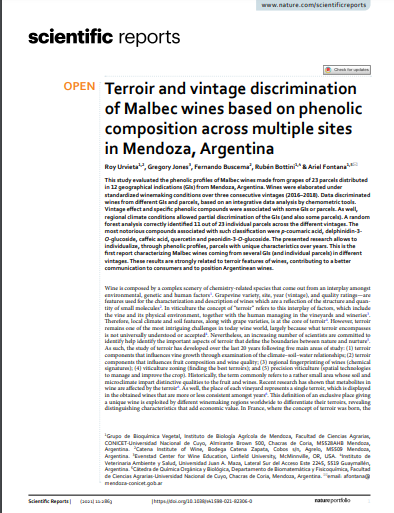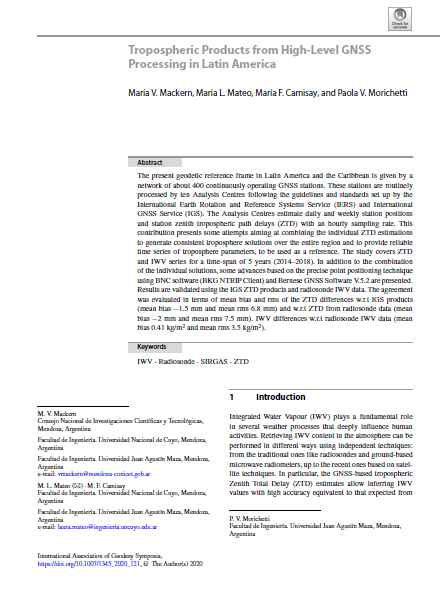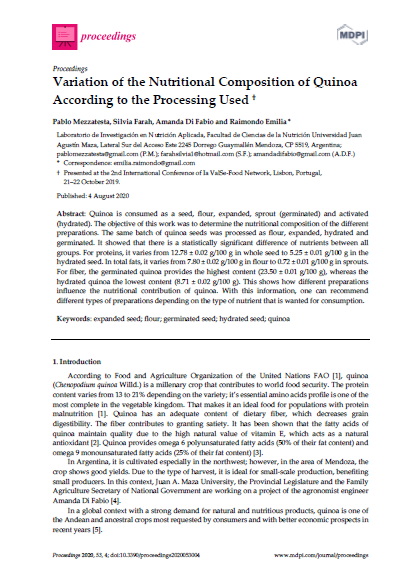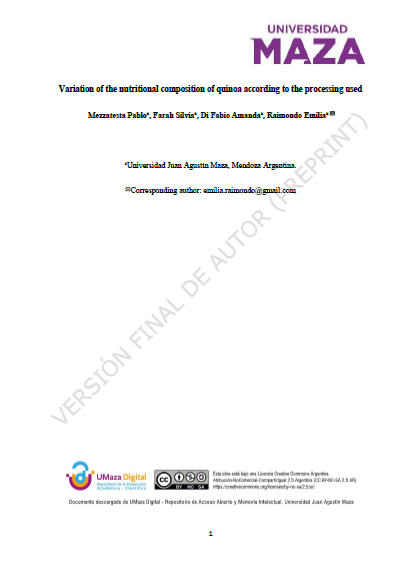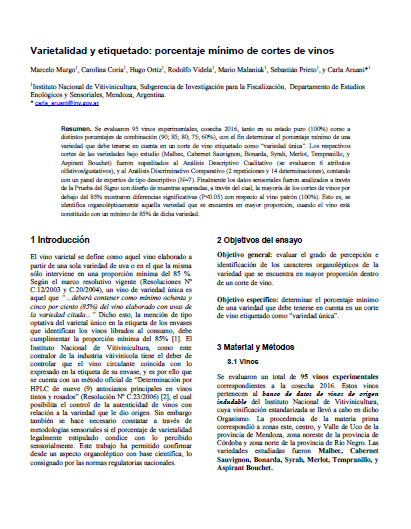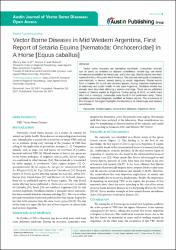Browsing Artículos científicos by Title
Now showing items 73-78 of 78
-
Terroir and vintage discrimination of Malbec wines based on phenolic composition across multiple sites in Mendoza, Argentina
(Scientifics Reports Editorial, 2021-02-03)This study evaluated the phenolic profiles of Malbec wines made from grapes of 23 parcels distributed in 12 geographical indications (GIs) from Mendoza, Argentina. Wines were elaborated under standardized winemaking conditions over three consecutive vintages (2016–2018). Data discriminated wines from different GIs and parcels, based on an integrative data analysis by chemometric tools. Vintage effect and specific phenolic compounds were associated with some GIs or parcels. As well, regional climate conditions allowed partial discrimination of the GIs (and also some parcels). A random forest ... -
Tropospheric Products from High-Level GNSS Processing in Latin America
(Editorial International Association of Geodesy Symposia, 2020-07-25)The present geodetic reference frame in Latin America and the Caribbean is given by a network of about 400 continuously operating GNSS stations. These stations are routinely processed by ten Analysis Centres following the guidelines and standards set up by the International Earth Rotation and Reference Systems Service (IERS) and International GNSS Service (IGS). The Analysis Centres estimate daily and weekly station positions and station zenith tropospheric path delays (ZTD) with an hourly sampling rate. This contribution presents some attempts aiming at combining the individual ZTD ... -
Variation of the Nutritional Composition of Quinoa According to the Processing Used
(Consejo Editorial Proceedings, 2020-08-04)Quinoa is consumed as a seed, flour, expanded, sprout (germinated) and activated (hydrated). The objective of this work was to determine the nutritional composition of the different preparations. The same batch of quinoa seeds was processed as flour, expanded, hydrated and germinated. It showed that there is a statistically significant difference of nutrients between all groups. For proteins, it varies from 12.78 ± 0.02 g/100 g in whole seed to 5.25 ± 0.01 g/100 g in the hydrated seed. In total fats, it varies from 7.80 ± 0.02 g/100 g in flour to 0.72 ± 0.01 g/100 g in sprouts. For fiber, the ... -
Variation of the nutritional composition of quinoa according to the processing used
(, 2020)In Mendoza, Argentina, quinoa is grown with a very good yield, and its consumption is becoming widespread. It is consumed as a seed, flour, expanded, sprout (germinated) and activated (hydrated). The popular belief is that all these forms have the same nutritional contribution. Taking into account this belief, the objective of this work was to determine the nutritional composition of the different preparations. The same batch of quinoa seeds was processed as flour, expanded, hydrated and sprout. It was analyzed by triplicate, applying conventional laboratory techniques. For the statistical ... -
Varietalidad y etiquetado: porcentaje mínimo de cortes de vinos
(Comité editorial BIO Web of Conferences, 2019-02-19)Se evaluaron 95 vinos experimentales, cosecha 2016, tanto en su estado puro (100%) como a distintos porcentajes de combinación (90; 85; 80; 75; 60%), con el fin determinar el porcentaje mínimo de una variedad que debe tenerse en cuenta en un corte de vino etiquetado como “variedad única”. Los respectivos cortes de las variedades bajo estudio (Malbec, Cabernet Sauvignon, Bonarda, Syrah, Merlot, Tempranillo, y Aspirant Bouchet) fueron supeditados al Análisis Descriptivo Cualitativo (se evaluaron 6 atributos olfativos/gustativos), y al Análisis Discriminativo Comparativo (2 repeticiones y 14 ... -
Vector Borne Diseases in Mid Western Argentina, First Report of Setaria Equina [Nematoda: Onchocercidae] in A Horse [Equus caballus]
(Comité editorial Austin Journal of Vector Borne Diseases, 2017-12-05)Vector borne diseases are spreading worldwide. Companion animals can be useful as sentinels for disease surveillance. Setaria spp. are filarial nematodes transmitted by Aedes spp. and Culex spp. Setaria equina has been reported in Asia, Africa and North America. This zoonotic nematode is frequently asymptomatic in horses, except during its erratic migrations. Filarial worms have a tropism for ocular and nervous tissues, having important implications in veterinary and public health. In mid west Argentina, Dirofilaria immitis has already been described affecting a woman and dogs. There are no ...







